Introduction
Determining the state of the art of a research topic has been the task that plagued the minds of scholars. Writers scour internet databases for journals and articles to find the latest trends in their field of study. This cumbersome undertaking holds true for researchers in English language teaching (ELT). With myriads of topics to choose from, ELT scholars will need to constantly keep abreast with the latest development in the field: prominent authors, flagship journals, and current topics. Nowadays, this laborious task is greatly facilitated by the use of technology, one of which is bibliometrics. Bibliometric tools can provide a mapping of state-of-the-art overview, the evolution of research, citation impact, collaboration profile, research positioning and showcasing, among others (Ranjbar-Sahraei & Negenborn, 2017). Notable studies in ELT employing bibliometric parameters have emerged in recent years (Aryadoust et al., 2020; Hyland & Jiang, 2020, Lei & Liu, 2019) and are expected to continue.
While the advent of the COVID-19 pandemic proved disastrous for the lives and health of millions, it inadvertently opened up a whole new paradigm in the world of research, specifically in education. The sudden shift to remote learning forced educational institutions to set up online learning systems where they did not exist in the shortest time possible. Teachers, parents, and students grappled with gadgets, learning management systems, and educational applications, which suddenly sprung up to cater to emergency learning needs. Even as the learning-from-home mode continued after a year in many countries due to the mutation of the virus, the online learning system gradually stabilized; both teachers and students (or their parents) got more adept at managing the technology in the teaching and learning process (Ginting et al., 2021; Escobar-Mejia et al., 2021). Later, with the sanitary condition improving in several countries, face-to-face or hybrid learning began to be implemented.
Consequently, ELT as part of the educational undertaking was markedly influenced by the emergency learning situation. What happened to the universe of ELT during the outbreak of the COVID-19 pandemic? Such a question has been raised because the pandemic challenged this educational field, one of the most dynamic around the globe. ELT has historically been characterized by the rise and fall of some approaches, methods, techniques, and strategies to respond to the dynamics of psychology, language/linguistics, education, and technology. While teaching English online had long existed before the coronavirus outbreak, the forced remote learning created a growth spurt in the number of studies examining the whole gamut of aspects related to virtual English classes (Cheung, 2021; Khatoony, 2020; Tarrayo et al., 2021; Wong, 2020; Yi & Jang, 2020; and many more). Thus, there is a need to synthesize the trends in the studies carried out by scholars worldwide in ELT during the COVID-19 pandemic. To this end, performing a bibliometric analysis provides a panoramic sketch of the trends of prolific authors, eminent journals, up-to-date topics, and authors’ institutional provenance. It is hoped that the result of this study will assist especially novice ELT writers in their quest for novel research topics and potential publications.
In sum, this study aimed to provide a brief overview, through bibliometric mapping, of ELT research worldwide during the pandemic (2020-2021). Specifically, this study is divided into the following types of bibliometric analyses:
- Descriptive: most productive author, institutions, journals and countries, most influential documents, authors, and journals as seen by the citation structure, as well as most frequently-appearing keywords in ELT research during the pandemic.
- Conceptual structure: co-word analysis to find the central theme and trends in ELT research during the pandemic, based on the relationship between keywords, as they appear in keywords provided by the authors and by the journals, in abstracts, and in titles.
- Intellectual structure: co-citation analysis to reveal the influence of authors over others, as shown by the references of articles written on ELT research during the pandemic.
- Social structure: to reveal collaboration between countries, authors, and institutions of ELT research carried out during the pandemic.
Literature Review
While Pritchard (1969) first coined the word ‘bibliometrics’ to replace the term ‘statistical bibliography,’ the name first appeared in French as ‘bibliométrie’ by Paul Otlet in 1934 (Estivals, 2012). Pritchard (1969) defined it as “the application of mathematics and statistical methods to books and other media of communication” (p. 349). The definition was further refined by Fairthorne (1969) as “quantitative analyses of the bibliographic features of a body of literature” (Lawani, 1980, p. 2). Earlier works on bibliometrics made use of bibliographies, citations, directories, and union lists as data sources (Lawani, 1980). Since then, bibliometrics has been used to develop citation indices (Garfield, 2007) to determine the productive authors, author collaboration profile, and research networks among other things (Hyland & Jiang, 2020).
Renowned scholars have conducted rigorous bibliometric investigations in the specialized field of ELT. With Scopus as the database, Aryadoust et al. (2020) carried out a review of intellectual domains, measurement, and validity in language assessment and SLA research. They divided the dataset into core journals, language assessment journals, and general journals in SLA and Applied Linguistics. Document co-citation analysis revealed that the core journals are focused on reading and listening comprehension assessment, In contrast, the themes of the general journals are primarily vocabulary, oral proficiency, essay writing, grammar, and reading (Aryadoust et al., 2020). Lei and Liu (2019) set out to find the trends in research in Applied Linguistics by examining articles from 42 SSCI-indexed journals published from 2005 to 2016 through bibliometric analysis. The aim was to find the most frequently occurring topics, most-cited research, and changes in research trends. Their study revealed that topics, such as sociocultural/functional/identity issues are on the rise. China was also identified as an emerging country in applied linguistics publications (Lei & Liu, 2019).
Similarly, Hyland and Jiang (2020) examined studies on English for academic purposes (EAP) in the past 40 years (1980-2020) to uncover the trends in research topics, prominent authors, influential journals, and productive countries through a bibliometric approach. It was found that topics in EAP, such as identity, interaction, and genre were burgeoning. Authors in this field are also inclined towards discourse analysis and the role of social relationships in learning and communication. The geographical mapping of the countries of origin showed that EAP is a body of research that is gaining global interest (Hyland & Jiang, 2020). Although our present work is not geared toward such extensive bibliometric analysis of the broad ELT field, these works serve as valuable references and guides.
Meanwhile, other types of bibliometric studies cover a smaller subset of the ELT domain. Darmawansah (2021), for example, made a bibliometric mapping of educational technology used in Indonesia from 2011 to 2020. He made use of the Web of Science as the data source and VOSViewer as the visualization tool. By employing co-authorship, co-occurrence, citation, and co-citation analysis, his findings revealed the names of the most influential author based on the number of citations, the institution with the most-cited papers, and the most-cited journals (Darmawansah, 2021). Julia et al. (2020) similarly carried out a bibliometric analysis of flipped classroom educational model, extracted from journals in the Scopus database spanning from 2010 to 2019. Some of their key findings were the most frequently-occurring keywords, namely “flipped classroom,” “active learning,” and “blended learning,” and that flipped classroom is an educational model that was still a rising trend. A bibliometric study on the impact of the Common European Framework of Reference (CEFR) on ELT was conducted by Runnels and Runnels (2019), using publications from 1990 to 2017. Although CEFR originated in Europe, and research continued to be predominant there, there is a growing indication of its influence outside of Europe, notably in Asia (Runnels & Runnels, 2019). In their investigation of research papers on ELT, Barrot et al. (2020) limited themselves to doctoral and master theses in the Philippines conducted between 2010 and 2018. In conclusion, they exhorted the country's relevant bodies and authorities to have a clear ELT research blueprint since only four ELT areas were extensively researched while 17 others remained under- or unexplored (Barrot et al., 2020). Our present study is similar to these studies and was very much guided by them.
On the other hand, bibliometric studies with the pandemic as the specific context outside the ELT fields were also found. Akintunde et al. (2021) used the Web of Science database to analyze and map articles worldwide dealing with mental health during the pandemic. They presented the most productive countries, active journals, authors, institutions, and funding organizations that contributed to the literature on mental health during the viral outbreak. Bibliometrics and VOSViewer were used as the data mapping tools. The global mapping pointed to the need for more significant intervention and funding in several countries where research publication in this field appears to be low (Akintunde et al). Rodrigues et al. (2020) performed a systematic literature review and bibliometric analysis to reveal the impact of COVID-19 on scientific research in education, business, economics, and management. For the bibliometric part, they used Web of Science as the database and Bibiliometrix as the tool. Overall, it appears that the pandemic had an adverse impact on scholars in management and education, as evidenced by the decline in the number of quality publications in this field during the pandemic period (Rodrigues et al., 2020). As these studies were carried out in a similar context as the present study, they are beneficial as a comparison and reference.
Method
Study Design
This study aimed to analyze research articles on ELT during the COVID-19 pandemic using a bibliometric approach, drawing from the Scopus database from 2020 to 2021. Bibliometric analysis, as compared with systematic literature review or meta-analysis, was the design of choice, as it can handle a large set of research data on a broad topic, enabling both quantitative and qualitative interpretation (Donthu et al., 2021).
Data Collection
The article search was performed in the Scopus database, as it offers a well-curated and high-quality collection of abstracts and citations, rendering it highly suitable for bibliometric studies (Baas et al., 2020). A study comparing Scopus and other databases acknowledged the emerging prominence of Scopus as the database of choice (Zhu & Liu, 2020).
The following search string was entered into the database on Oct 13, 2021: TITLE-ABS-KEY ( "english language teaching" OR "english teaching" OR "teaching english as" OR "english as a second language" OR "english as a foreign language" OR "english language learning" OR "english learning" OR "english education" OR "english language education" ) AND ( LIMIT-TO ( PUBSTAGE , "final" ) ) AND ( LIMIT-TO ( PUBYEAR , 2022 ) OR LIMIT-TO ( PUBYEAR , 2021 ) OR LIMIT-TO ( PUBYEAR , 2020 ) ) AND ( LIMIT-TO ( DOCTYPE , "ar" ) ) AND ( LIMIT-TO ( SUBJAREA , "SOCI" ) OR LIMIT-TO ( SUBJAREA , "ARTS" ) ) AND ( LIMIT-TO ( LANGUAGE , "English" ) ) AND ( LIMIT-TO ( SRCTYPE , "j" ) ). Therefore, the search was limited by the keywords, publication year, document type, publication type, subject areas, and language. Under subject area, the search was specified into both “Social Science” and “Arts” in order to encompass the field of Education and Linguistics under the former and Language and Linguistics in the latter. With these parameters, the search returned data containing 2,273 documents, which were then saved in two .csv files since Scopus search is limited to 2,000 documents at any one time. The combined files were then uploaded to Bibiliometrix (Aria & Cuccurullo, 2017) for mapping, visualization, and analysis.
Results
The complete dataset presented here can be accessed online in the Supplementary Material[1]. A summary of the main features of the data obtained is presented in Table 1.

Table 1: Summary of the data obtained
Descriptive Analysis
Most productive authors, institutions, countries, and journals
In the first part of the descriptive analysis, the list of the top ten most productive aspects, such as authors, institutions, journals and countries in ELT research during the COVID-19 pandemic, is presented in Tables 2a-d. “NP” indicates the number of publications.
For the top ten most productive authors, as shown in Table 2a, 159 authors with two or more publications between 2020 and 2021 were identified. At the top of the chart is Melor Md Yunus with 15 publications, followed by Lawrence Jun Zhang with ten, and Dario Luis Banegas with eight publications.

NP: Number of Publications
Table 2a: Top ten most productive authors
The search for the top ten most productive affiliations was filtered by limiting the number of publications to a minimum of four. The search returned 160 institutions. In Table 2b, it can be seen that Universiti Kebangsaan Malaysia is the first with 42 publications, followed by The Education University of Hong Kong with 34, and Prince Sattam Bin Abdulaziz University in Saudi Arabia is third with 25 publications.

NP: Number of Publications
Table 2b: Top ten most productive affiliations
Table 2c also reveals the top ten most productive countries. The list is topped by the USA (NP = 281), China (NP = 275), and Indonesia with 228 publications.
NP: Number of Publications

NP: Number of publications
Table 2c: Top ten most productive countries
The interplay of authors, affiliations, and countries reveals that the most productive author, Yunus, M. M., which is subsequently identified as Melor Md Yunus, belongs to Universiti Kebangsaan Malaysia, which is also the most productive affiliation. Another noted coincidence is that of author no. 5, Basthomi, Y., or Yazid Basthomi from the Universitas Negeri Malang, which is the fourth most productive institution, while Indonesia also occupies the third position in the production by country.
Lastly, the top ten most productive journals in ELT during the pandemic are also presented in Table 2d. The search was limited to journals publishing a minimum of three articles during the pandemic. The Asian EFL Journal leads the list with 76 articles, followed by System with 58 articles, and the International Journal of Emerging Technologies in Learning, which published a total of 53 articles.
NP: Number of Publications

NP-Number of publications.
Table 2d: Top ten most productive journals
Another way of presenting the productive authors, specifically concerning their countries and keywords of their works, is by using the three-fields plot, as shown in Figure 1. The left boxes represent the authors’ countries, and the right shows the authors’ keywords with the authors’ names in the middle. As shown in Figure 1, China has the highest number of authors’ affiliations, as indicated by the height of the box, followed by Malaysia and the USA. Looking at the lines’ thickness, the prominent authors from China are Wang, Y., Li, Y., and Zhang, H., which are also represented by the boxes’ height corresponding to their names. Yunus, M. M. and Hashim H. are the prolific authors from Malaysia while Zhang, H. (also affiliated with China) and Kim, Y. are the main contributors from the USA. As for the keywords, the most prominent author Yunus, M. M. wrote about ‘reading comprehension,’ ‘vocabulary,’ and ‘motivation’ besides using keywords, such as ‘ESL.’ Wang, Y. focused on ‘teacher education.’ Lastly, Li, Y. wrote mostly on ‘English teaching.’
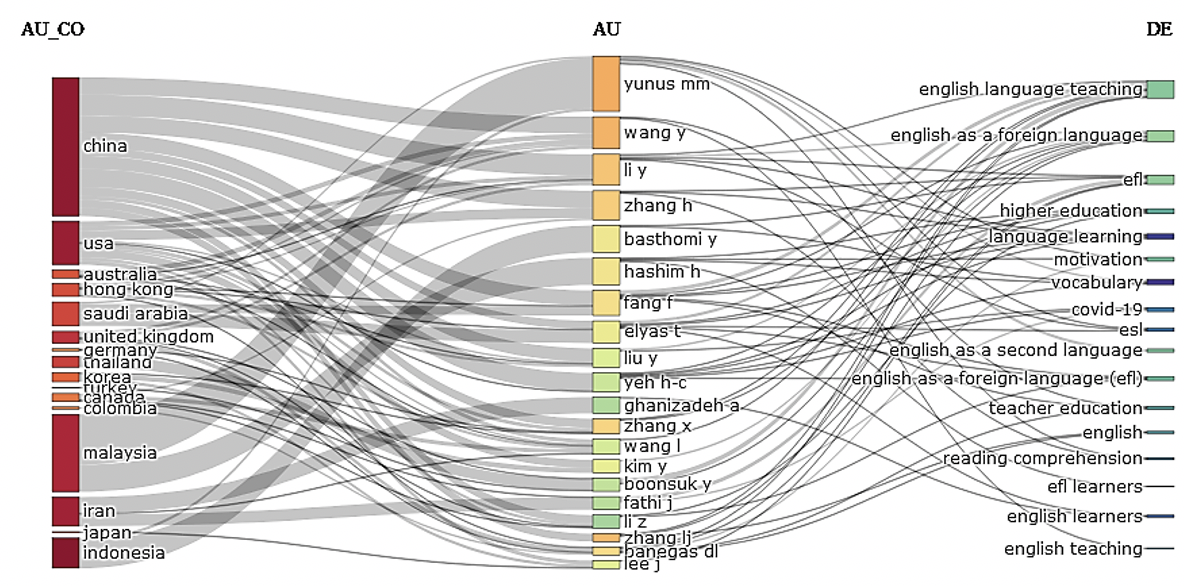
Figure 1: A three-fields plot of countries, authors, and authors’ keywords
Top ten most cited
Besides measuring elements of productivity by authors, institutions, countries, and journals in ELT research during the pandemic, the impact and influence of the publications also need to be assessed through citation and h-index measures (Donthu et al., 2021), where h-index counts h number of publications that have been cited at least h times (Hirsch, 2005). Consequently, citation count analysis was done to find the most influential authors, journal articles, and corresponding authors’ countries for ELT research published during the pandemic.
For authors, a total of 1,858 authors (with citation data) from the database were identified. Table 3 lists the top ten authors with the details pertaining to their h-index, total citations, the number of publications, and institutions. Following the h-index, the most prominent author in ELT during the pandemic is shown to be Teng F, with h-index (n = 5), number of publications (NP = 5), and total citation times (TC = 59). He is identified to be Mark Feng Teng from Beijing Normal University. He is followed by Koller O (h-index (n = 4), (NP = 4), (TC = 20)), or Olaf Köller, a professor of educational research from Leibniz Institute for Sciences and Mathematics Education who specializes in education psychology. Lou N. M. (h-index (n = 4), (NP = 4), (TC = 37)) comes in third and refers to Nigel Mantou Lou, Assistant Professor of Psychology at the University of Victoria.

TC: Total Citations, NP: Number of Publications
Table 3: Top ten authors by h-index
Meanwhile, the top ten impactful journals by h-index are shown in Table 4. Language Teaching Research journal occupies the top position with h-index of 8, followed by Computer Assisted Language Learning with h-index of 6, and Innovation in Language Learning and Teaching, which also has an h-index of 6. For a journal, the h-index implies that the author has published h articles and has been cited at least h times. The g-index signifies at least g2 citations for the top g articles arranged in descending order based on the number of citations (Egghe, 2006). For example, a g-index of 20 means that the journal has 20 articles that altogether have been cited 400 times. Lastly, the m-index is the normalization of the h-index; that is, the h-index divided by the number of years of the authors’ publication activity.
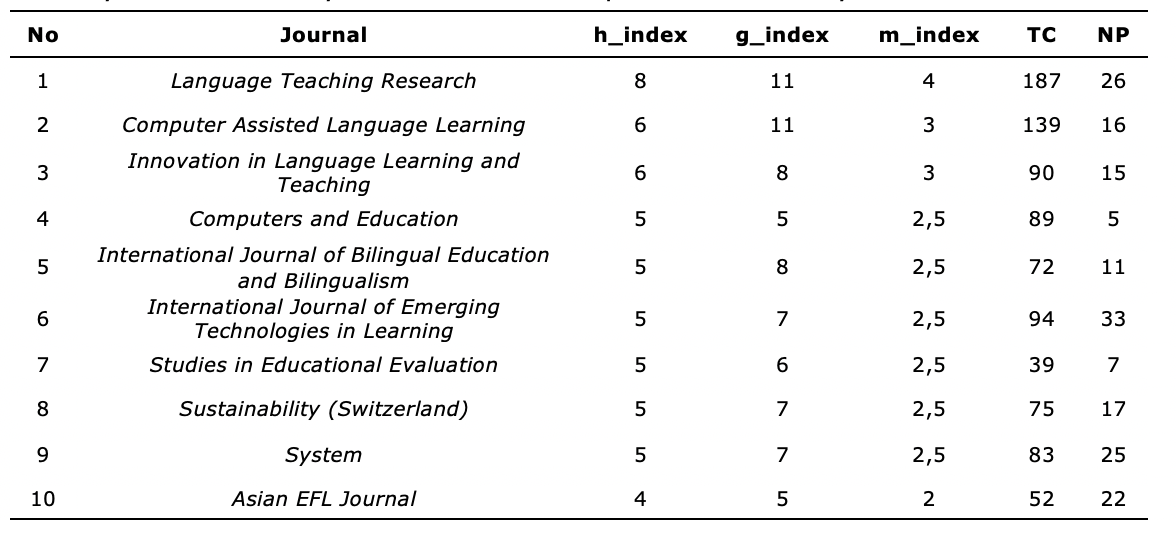
TC: Total Citations, NP: Number of Publications
Table 4: Top ten journals by h-index
Table 5 reveals the top ten most cited articles. Of the 2,273 articles retrieved, 958 or approximately 42.15%, were cited. The top ten most-cited articles in Table 4 represent 8.78% (TC = 258) of the total citations of 2,837 for the 958 articles. Out of the ten documents, two are single-authored. A glance at the title and the source reveals that four out of ten are articles related to technology (Articles 1, 2, 5, and 9), and four deal with psychological aspects, such as learning enjoyment, anxiety, and affective factors (Articles 3, 4, 6 and 7).

TC: Total Citations
Table 5. Top ten most cited articles
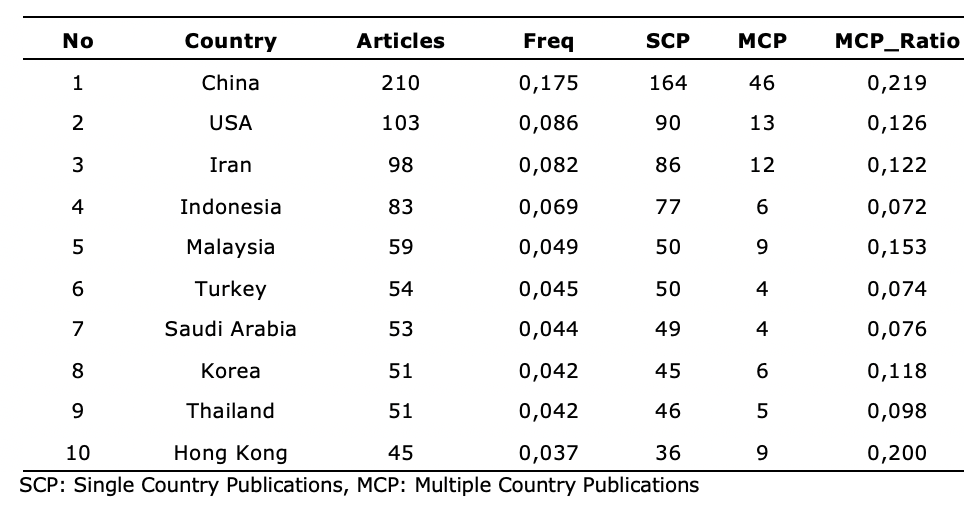
SCP: Single Country Publications, MCP: Multiple Country Publications
Table 6: Top ten most cited countries by corresponding authors
In terms of relevant countries based on the corresponding authors, it can be seen from Table 6 that authors from China produced the highest number of cited articles (n=210), out of which 164 were published by authors affiliated only in China, and 46 were written by at least one co-author from another country. China also has the highest MCP ratio of 0.219. The next most-cited countries are the USA (n=103) and Iran (n=98). However, it is interesting to note that, although Hong Kong only occupies the tenth position, it is second after China in terms of MCP ratio, thus reflecting the high degree of collaboration of authors from that country.
Characteristics of authors’ keywords
In the last part of the descriptive analysis, the top ten authors’ keywords, as shown in Table 7, are also presented to see the more prominent ones used by ELT authors during the pandemic.
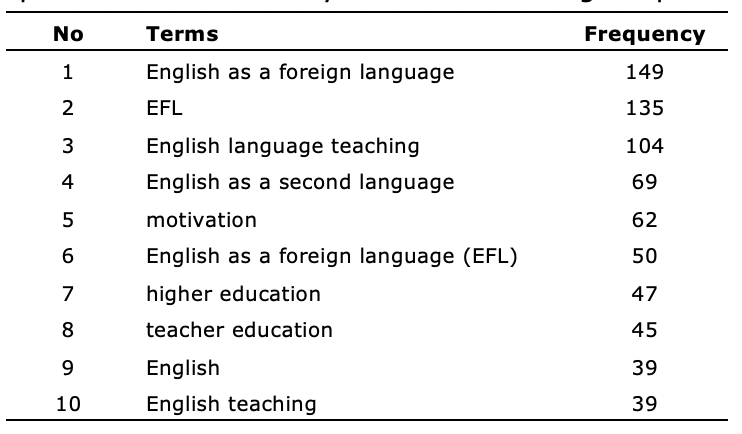
Table 7: Top ten most frequently occurring authors’ keywords
It can be seen from Table 6 that, eliminating terms related to English language and English teaching (e.g., ‘English as a foreign language,’ ‘EFL,’ ‘English language teaching,’), ‘motivation’ (n = 62) appeared to be the most frequent, followed by ‘higher education’ (n = 47) and ‘teacher education’ (n = 45).
Conceptual Structure
In order to determine the most relevant themes and concepts that have been researched in ELT during the pandemic, as well as the inter-relationality between them, a co-word analysis was performed in order to reveal the co-occurrence network map (Aria & Cuccurullo, 2017; Sharma et al., 2021). The analysis can be carried out using abstracts, author’s keywords, keyword plus (provided by the journal), and titles as the unit of analysis.
The visualization for the results of the authors’ keyword co-occurrence analysis is shown in Figure 2. The size of the nodes represents the frequency of occurrence, and the intensity of the connecting line reflects the frequency of the co-occurrence between any two keywords.
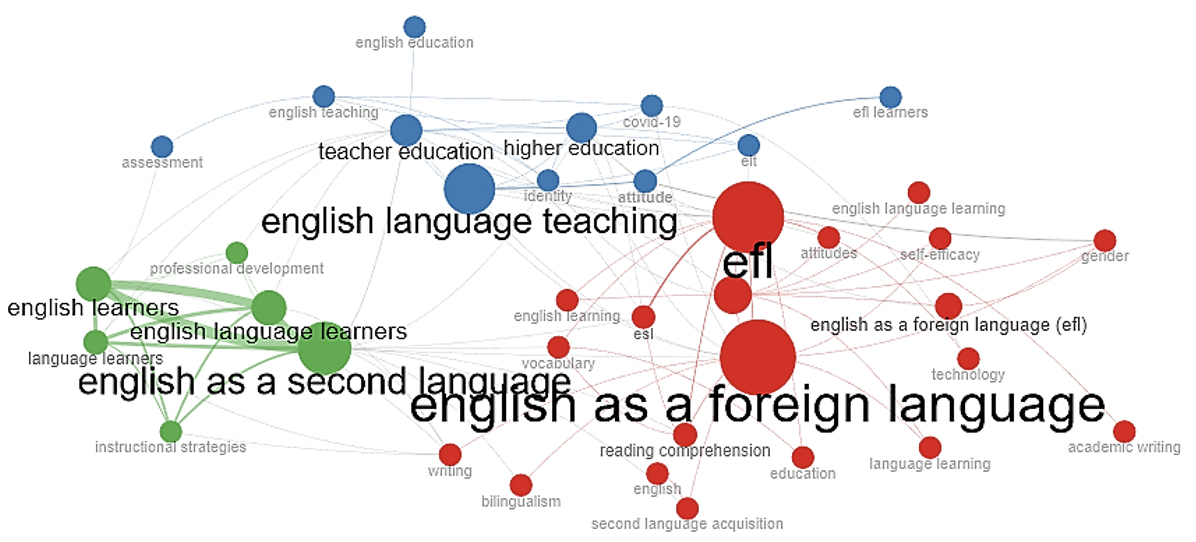
Figure 2: Co-occurrence analysis network of authors’ keywords
The complete list of the clusters and the keywords within is shown in Table 8.

Table 8: Keywords within each cluster of co-occurrence analysis
In Cluster 1 (green), ‘English as a second language’ appears as the central theme and is closely related to the keywords related to English language learners, professional development, and instructional strategy. The thickness of the lines connecting those keywords in Cluster 1 indicates that they frequently occur together. Next, Cluster 2 (red) has ‘English as a foreign language’ in its center. In broad terms, it is closely connected to keywords related to psychological perspective in language learning, such as ‘motivation,’ ‘attitude,’ ‘perceptions,’ and ‘self-efficacy.’ There are also keywords related to the learners, such as ‘gender,’ ‘English learning,’ and ‘self-regulated learning.’ Linguistic categories like ‘writing’, ‘vocabulary’, and ‘reading comprehension’ were also found. Lastly, ‘English Language teaching’ is the focal point of Cluster 3 (blue). Almost similar to Cluster 2, it frequently appears together with psychological terms (‘identity,’ and ‘attitude). In addition, contextual factors, namely ‘higher education’ and ‘teacher education’ are also present in this cluster.
The links to the VOSViewer 1.6.17 visualizations of other co-occurrence analyses with abstracts, keyword plus, and titles are available in the Appendix.
To represent the co-occurrence network in a different way, the factorial analysis in was also carried out. The multiple correspondence analysis (MCA) method was chosen, using the Authors’ Keywords as the field. The result of the MCA map is shown in Figure 3, which displays two distinct clusters.
The first cluster (red) comprises several groups, namely language aspects (‘vocabulary,’ ‘reading and reading comprehension,’ ‘writing,’ ‘grammar,’ and ‘pronunciation’), language learning (‘second language acquisition,’ ‘bilingualism,’ ‘self-efficacy,’ and ‘self-regulated learning’), linguistics (‘error analysis’ and ‘conversation analysis’), technology (‘blended learning,’ ‘online learning,’ and ‘mobile learning’), and psychological perspective (‘gender,’ ‘perception,’ ‘motivation,’ and ‘identity’). There are 46 keywords in this cluster. The second cluster (blue) is much smaller in size, containing only four keywords, and concerns the learners and speakers of English.
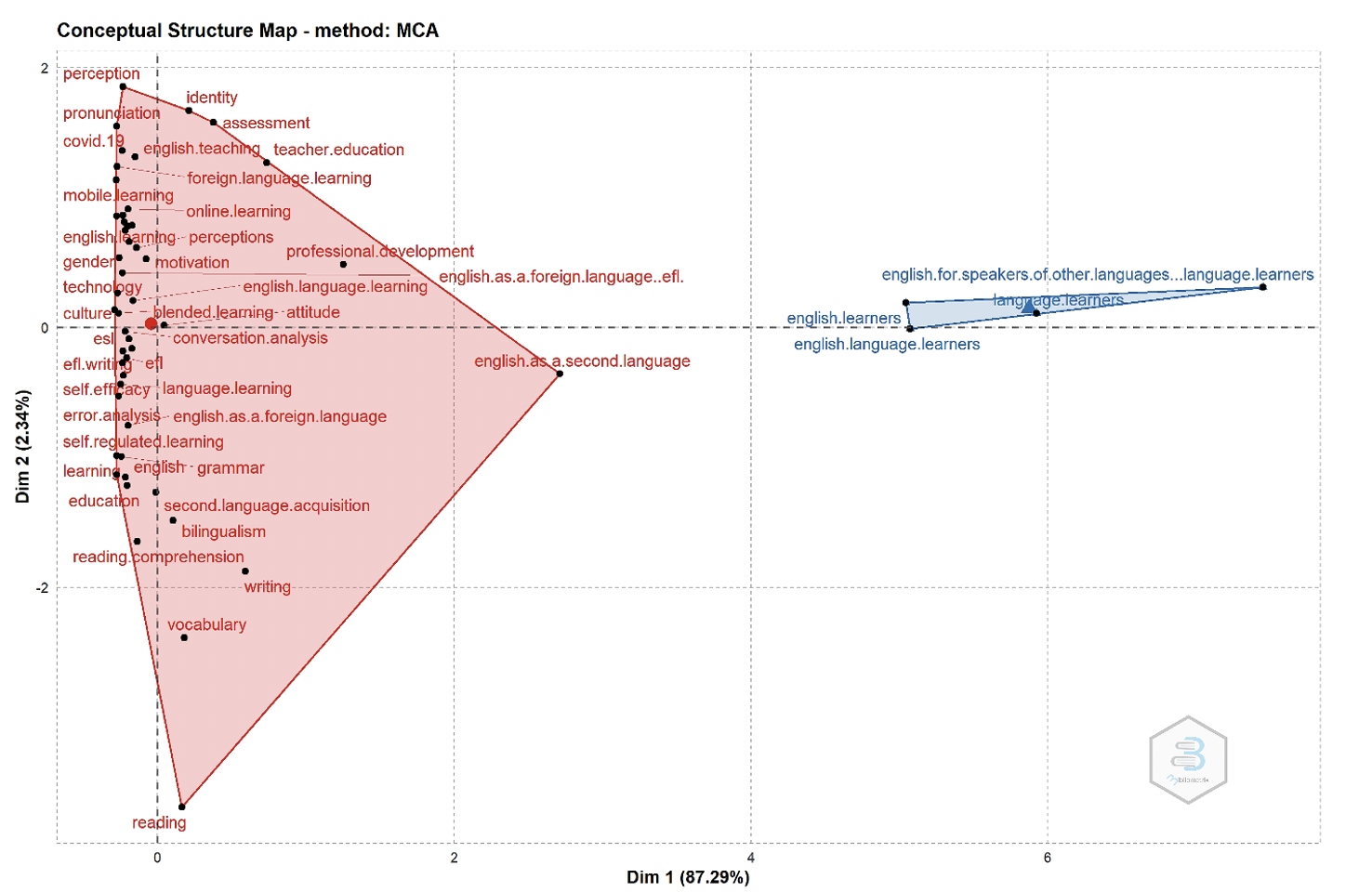
Figure 3: Conceptual structure map with MCA method on authors’ keywords
Thematic analysis is able to reveal the interconnection of a unit, such as the author’s keywords, keyword plus, abstract, or title, in order to find themes, which are mapped out using density and centrality parameters (Agbo et al., 2021). Depending on the degree of correlation among topics (centrality) and the cohesiveness among nodes (density), the themes in their clusters are mapped out along four quadrants. The quadrant on the top right (Q1) represents the motor theme; the bottom right (Q2) represents the basic theme; the top left (Q3) represents the niche theme; and the bottom left (Q4) represents the emerging or declining theme.
The thematic map using authors’ keywords as the field is given in Figure 4, and the complete list of keywords in each quadrant is shown in Table 9.

Table 9. Authors’ keywords within each quadrant of the thematic map
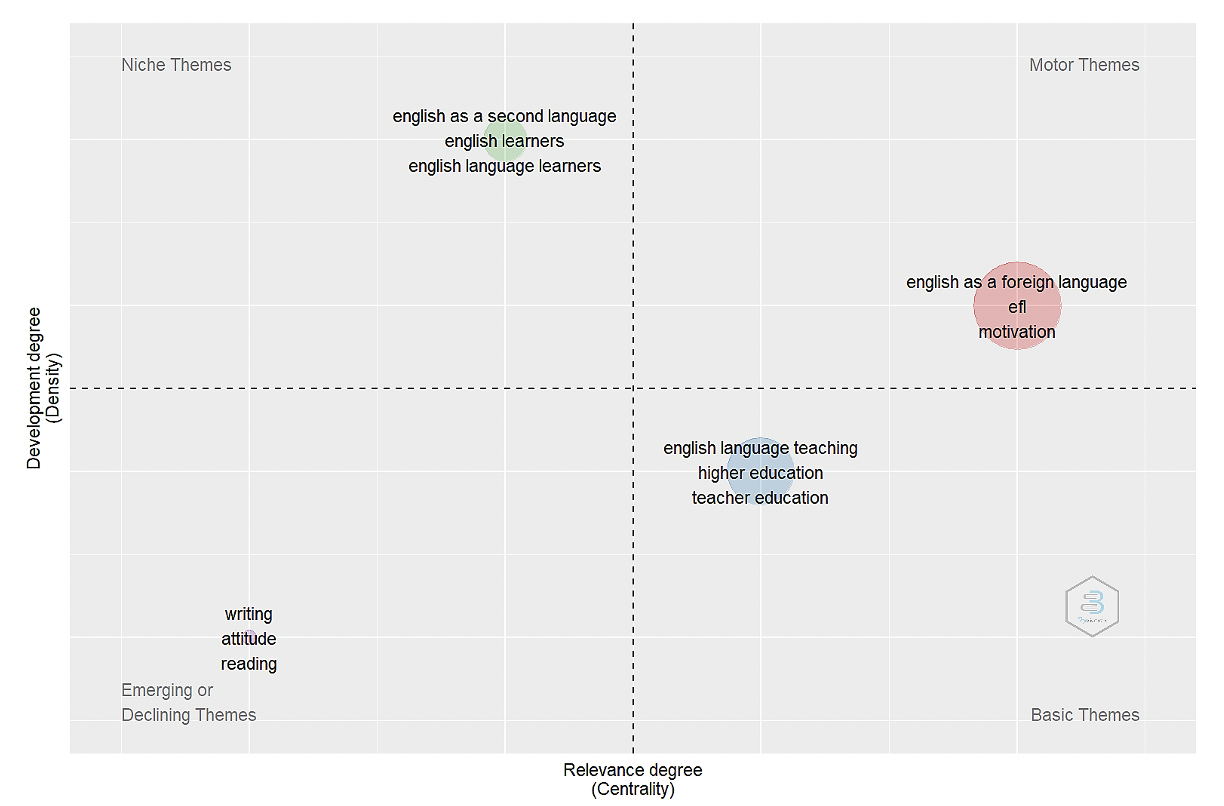
Figure 4: Thematic map on authors’ keywords
This, it can be implied that, during the pandemic, the themes in Q2, such as higher education, teacher education, and motivation, have been well-established and continue to be relevant in ELT. Themes in Q1 (primary and secondary education, social media, interaction, and qualitative research) are the leading themes during the pandemic. In Q3, themes (i.e., ‘English language learners,’ ‘professional development,’ ‘instructional strategies,’ ‘adolescence,’ ‘childhood,’ and ‘comprehension’) have somehow formed strong links among themselves as specialized areas. Lastly, the themes in Q4, namely ‘writing,’ ‘reading,’ ‘speaking,’ and ‘attitude,’ might be either emerging or declining; further analysis will need to be carried out to determine which.
Intellectual Structure
The intellectual linkage between authors, sources (journals), and works (articles) is shown as the intellectual structure of the field and is revealed through co-citation analysis (Aria & Cuccurullo, 2020). It is based on the principle that a common theme will be shared by two documents cited together in subsequent articles (Sharma et al., 2021). The size of the nodes reflects the number of citations received by that reference while the intensity of the lines between nodes shows the link strength between the two references.
Figure 5 shows the visualization of co-citation analysis using cited references as the unit of analysis. Four clusters were identified. Cluster 1 (red) features the work of Braun (2006) on thematic analysis in psychology, which seems to be the most prominent, as the node size shows. In Cluster 2 (purple), English as a global language, as proposed by Crystal (2003), takes center stage. Next, Dornyei, (2005) with his writings on language motivation, is the most influential in Cluster 3 (blue). Bandura (1986, 1997), who wrote about social cognitive theory and self-efficacy, formed the fourth cluster (green). The smallest cluster (yellow) has the works of Wenger (1998) and Lave (1991), who promoted the concept of community of practice.

Figure 5: Co-citation network of papers (references)
Similarly, the visualization of co-citation analysis of sources (journals) is shown in Figure 6. Four clusters emerged. The largest one, shown in red, is led by the journal System and comprises other well-known journals in ELT (e.g., TESOL Quarterly, Language Learning, and The Modern Language Journal). The next cluster (green) contains several technology-related journals, like Computer Assisted Language Learning, Computer & Education, and Language Learning & Technology. The third cluster (purple) comprises a few journals of psychology, such as the Journal of Educational Psychology, Contemporary Educational Psychology, and Educational Psychologist. Lastly, a small cluster (blue) is made up of the Journal of Second Language Writing, English for Specific Purposes, and Journal of English for Academic Purposes.
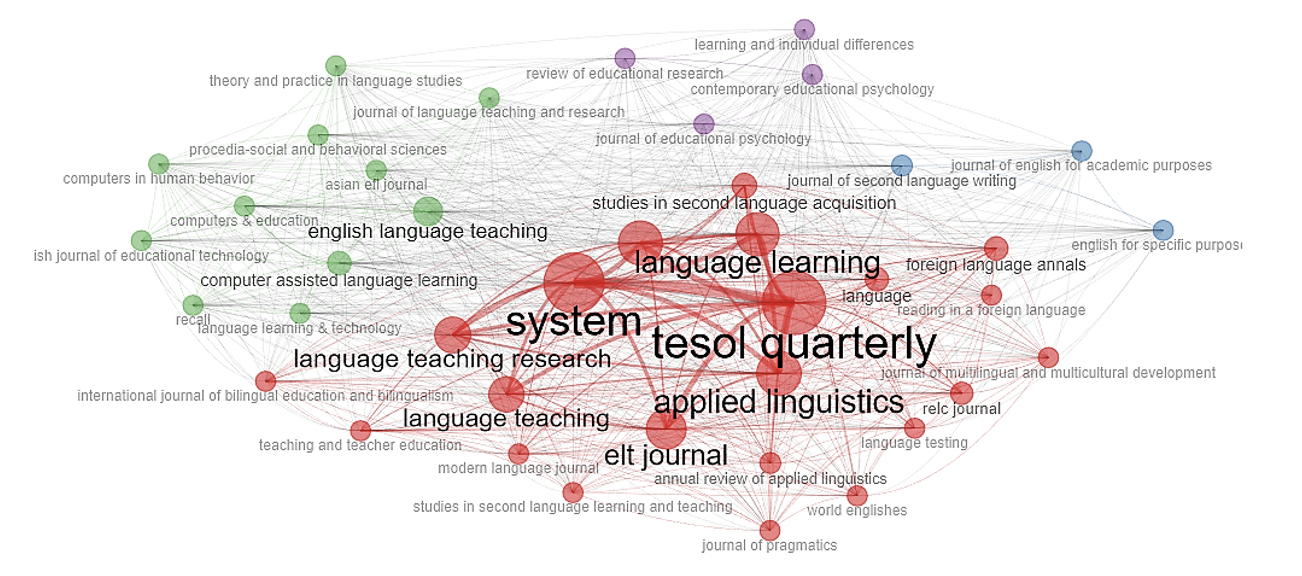
Figure 6: Co-citation network of sources (journals)
Alternative mapping of the intellectual structure using VOSViewer 1.6.17 is also available in the Appendix by clicking on the links provided.
Social Structure
Social structure (co-author) analysis reveals collaboration between countries, institutions, and authors. Figure 7 unveils the country-collaboration network in the ELT research during the pandemic. The first cluster (blue) has China at the center, together with the USA, Ecuador, Hong Kong, Japan, Korea, and Chile in the same cluster. The collaboration between China, the USA, and Hong Kong appears strong, as indicated by the intensity of the connecting lines. Cluster 2 (red) is led by Indonesia, in collaboration with surrounding Asian countries (Iran, Oman, Turkey, and the United Arab Emirates), as well as others (Australia, Canada, France). The UK leads in the third cluster (purple) with several European countries (the Netherlands, Poland, Sweden, etc.), Latin American countries (Colombia, Mexico, and Brazil), and Asian countries (Philippines and Thailand). The fourth cluster (green) comprises Saudi Arabia as the biggest node, accompanied by Jordan, Pakistan, India, Malaysia, Bangladesh, Kazakhstan, Iran, and Ukraine.

Figure 7: Country collaboration network
Finally, Figure 8 depicts the collaboration between institutions. The node size shows that the Islamic Azad University of Iran is the most prominent, collaborating with the Prince Sattam bin Abdul Aziz University of Saudi Arabia. The second cluster comprises the Education University of Hong Kong together with the Hong Kong Baptist University. In Indonesia, the Universitas Negeri Malang, Universitas Pendidikan Indonesia, and Universitas Syiah Kuala form the third cluster. Lastly, the University of Amsterdam and the Radboud University in the Netherland make up the fourth cluster.

Figure 8. Collaboration network of universities
Similarly, the Appendix contains links to alternative visualization for social structure using VOSViewer 1.6.17.
Discussion
This study set out to reveal the characteristics of ELT research carried out during the COVID-19 pandemic through Bibliometric analysis and parameters, namely descriptive analysis vis-a-vis productivity and impact, and the conceptual, intellectual, and social structure. The rigorous search from the Scopus database returned 2,273 documents written in English between 2020 and 2021. This work aimed to provide a sketch of the ELT works produced during the outbreak and to offer some insights for novice researchers who wish to discover trending topics, novelties, and directions for their works.
Firstly, some observations can be made on the data summarized in Table 1. Under Authors Collaboration, it can be seen that there are 766 single-authored documents out of the total of 2273, which represents approximately 33.7% of the total articles. This authorship trend is in line with Navaneethakrishnan’s (2014) findings, who studied the authorship pattern in social science publications in Sri Lanka and found that single-authored papers made up 35% of the total. The table also depicts the figure of 2.21 co-authors per document. In their study of bibliometric analysis across various disciplines, Harzing and Alakangas (2015) also noted that publications in social science are typically written by 2 to 2.5 authors, as compared with engineering (4 authors), science (5 authors) and life sciences (6.5 authors). The data in this study then corroborate their findings. On the other hand, when focused on the field of language and linguistics, sole authorship is more common, perhaps due to the competitive nature of the field and the want for common research agenda (Syahid, 2021).
Next, authors and institutions from Asia appeared to be dominant in productivity, especially in the top ten authors, affiliations, and countries. The only non-Asian countries listed were the USA and the UK. A similar picture emerged upon analyzing the impacts and relevance of authors, articles, and countries. Of the top ten most relevant authors, apart from two who are based in Europe and South America, the rest hail from Asia. China and Chinese authors notably occupy top positions in productivity and impact. This trend has been predicted by Lei and Liu (2019) in their bibliometric study on the applied linguistics field from 2005 to 2016 and further confirmed by Zhang (2020) in his bibliometric study of second language acquisition. The appearance of several Southeast Asian countries (Indonesia, Malaysia, and Thailand), as well as authors and institutions from those countries, in both the productivity and impact list, is a novelty with regards to the list made by Barrot (2017), who singled out Brunei, Singapore, and the Philippines, as prominent Southeast Asian countries with research in language and linguistics. Overall, this might reflect the growing influence of Asia on the English education milieu.
Thirdly, ELT research during the pandemic seems to revolve around two central themes, namely technology and psychology, apart from the usual ELT, education, and other language aspects, such as writing, reading, and speaking. Three are technologically oriented in the top ten most relevant journals (e.g., Computer Assisted Language Learning, Computers and Education, and International Journal of Emerging Technology in Learning). Of the top ten most cited articles, four are related to technology and another four to psychology. The dominance of the two themes is also reflected in the intellectual structure analysis, as revealed by the co-citation network of journals, which mapped out two distinct clusters of technology and psychology-themed journals.
This phenomenon is not unexpected since the COVID-19 pandemic with its consequent closure of schools and sudden enactment of online learning, inexorably garnered ELT scholars’ interest to focus their works around a technological topic. At the same time, the forced seclusion at home might have generated psychologically-related issues in English learning, such as (de)motivation, self-regulation, (dis)engagement, and enjoyment. Thus, it is hardly surprising that these two topics proliferated during the pandemic. Demiray Akbulut (2020), in her bibliometric analysis of EFL studies in Turkey from 1990 to 2020, also listed Experimental psychology and computer science as the top ten dominant discipline areas, apart from education, language, linguistics, and teacher research. However, unlike Demiray Akbulut, this present study did not find (English) literature among the keywords or topics during the pandemic.
In terms of trending topics, as indicated by the thematic map in this study, it appears that qualitative research at primary and secondary education levels on interaction in social media is the topic, which is on the rise. Again, this might reflect the impact of the pandemic on English education and research, where teachers and students turn to social media as a learning platform. Social media research in education has indeed shown steady growth in both productivity and citations, as suggested by the bibliometric analysis of Barrot et al. (2020). The finding in this study is also in line with that of Demiray Akbulut (2020), who identified CALL and Technology as one of the rapidly rising topics in EFL research in Turkey in recent years. Her study also revealed corpus-based studies as another fast-growing topic in Turkey. Interestingly, this term is entirely absent in this present study.
The thematic map also depicted keywords like ‘writing,’ ‘attitude,’ ‘reading,’ and ‘speaking’ to belong to the fourth quadrant, which means that they are either emerging or declining. Demiray Akbulut (2020) also indicated ‘writing’ as one of the topics, which suffered a significant decrease in EFL studies in Turkey. However, it may not be due to the waning interest of scholars in those topics; it might mean that the keywords used nowadays are bigrams, such as ‘extensive reading’ or ‘academic writing.’ Demiray Akbulut’s list of topics on the decline also had ‘cultural studies’ and ‘young learners.’ Those topics are also absent in this study.
For intellectual structure, the analysis for references revealed five clusters led each by Braun (2006), Crystal (2001), Dornyei (2005), Bandura (1986, 1997), and Wenger (1998). Zhang’s (2019) study on SLA research between 1997-2018 also listed Dornyei (2005) in the list of highly influential references. Thus, Dornyei’s work on individual differences remains relevant up to now. Other prominent references in Zhang (2020) included Nation (2001) and Wray (2002), who researched on vocabulary and corpus-based research, respectively. These two themes did not seem to be the focus of ELT research in this pandemic.
In the analysis of sources (journals), the result of this study is similar to that of Zhang (2020) in the emergence of four journal clusters. This study produced ELT, technology, educational psychology, and ESP/EAP clusters, somewhat akin to Zhang’s clusters of psycholinguistics, SLA/SLT, linguistic/formal approach, and technology-based SLA. However, the technology-based SLA cluster in Zhang was still emerging while the corresponding cluster in this study is quite substantial. Once again, this reflects the growing popularity of research in this area.
Lastly, the social structure analysis of countries again unveiled the increasing productivity of ELT research in Asian countries. Strong collaboration was reflected among co-authors from China, Hong Kong, and the USA. Other clusters were led by Asian countries, such as Indonesia, Saudi Arabia, and Thailand. it is also shown that authors from the UK form a wide array of collaborations with authors from Asia, Europe, and South America. Hence, ELT research during the pandemic still has not seen a significant contribution from and collaboration with African countries. The institutional clusters shown in this study are relatively small and isolated; they can be simplified into Hong Kong, Indonesia, Iran, and Holland clusters. It is unclear whether this is the pandemic’s impact; the movement restriction hindered institutional collaboration.
This study is among the first attempts at a bibliometric analysis of ELT research during the COVID-19 pandemic with several implications for research. Firstly, this study offers a list of prominent authors, journals, and articles in ELT at this present moment, which might be helpful as a scholarly reference. Next, the conceptual and thematic analysis also provides insight into trending keywords, potential novelties, as well as perennial topics that are foundational to the discipline. Lastly, the highly-cited journals can also guide writers as sources or target journals for article submission (Zhang, 2020).
This study possesses some limitations. The use of Scopus as the sole database could have been enriched by others, such as Web of Science (WOS), Google Scholar, PubMed, or EBSCO. On the other hand, merging more than one database poses potential difficulties in terms of overlapping data and differing citation systems. Thus, drawing from a single database prevents distortion in the data and their analysis. Nevertheless, a very recent article by Caputo and Kargina (2022) offered tips on how to merge Scopus and WOS in three easy steps successfully. Further bibliometric works may refer to their article for reference. Secondly, refinement of keywords to unify similar concepts (“data cleaning”) in Zhang (2020)) was not carried out.
For future research, ELT researchers interested in bibliometrics can carry out similar research using different databases, or perform this same study after two years, in order to paint the post-pandemic ELT research landscape in comparison to what has been sketched in this article.
Conclusion
This study was undertaken as an attempt to paint the ELT research landscape during the pandemic using bibliometric analysis in order to reveal the descriptive data, conceptual, intellectual, and social structure of ELT research in the 2020-2021 period. Data were retrieved from the Scopus database and analyzed using Bibliometrix tool. In brief, the findings revealed the growing prominence of Asian countries in ELT research and increasing trends in technological and psycholinguistic-related topics. On the other hand, topics such as cultural studies, corpus-based research, and young learners were absent from the list. This study is hoped to serve as a helpful reference for novice researchers regarding the most relevant authors, articles, and journals in ELT, even as we, hopefully, enter the post-pandemic period.
References
Agbo, F. J., Oyelere, S. S., Suhonen, J., & Tukiainen, M. (2021). Scientific production and thematic breakthroughs in smart learning environments: A bibliometric analysis. Smart Learning Environments, 8. https://doi.org/10.1186/s40561-020-00145-4
Akintunde, T. Y., Musa, T. H., Musa, H. H., Musa, I. H., Chen, S., Ibrahim, E., Tassang, A. E., & Helmy, M. S. E. D. M. (2021). Bibliometric analysis of global scientific literature on effects of COVID-19 pandemic on mental health. Asian Journal of Psychiatry, 63. https://doi.org/10.1016/j.ajp.2021.102753
Aria, M., & Cuccurullo, C. (2017). Bibliometrix: An R-tool for comprehensive science mapping analysis. Journal of Informetrics, 11(4), 959-975. https://doi.org/10.1016/j.joi.2017.08.007
Aryadoust, V., Zakaria, A., Lim, M. H., & Chen, C. (2021). An extensive knowledge mapping review of measurement and validity in language assessment and SLA research. Frontiers in Psychology, 11. https://doi.org/10.3389/fpsyg.2020.01941
Baas, J., Schotten, M., Plume, A., Côté, G., & Karimi, R. (2020). Scopus as a curated, high-quality bibliometric data source for academic research in quantitative science studies. Quantitative Science Studies, 1(1), 377-386. https://doi.org/10.1162/qss_a_00019
Barrot, J. S. (2017). Research impact and productivity of Southeast Asian countries in language and linguistics. Scientometrics, 110, 1-15. https://doi.org/10.1007/s11192-016-2163-3
Barrot, J. S., Acomular, D. R., Alamodin, E. A., & Argonza, R. C. R. (2020). Scientific mapping of English language teaching research in the Philippines: A bibliometric review of doctoral and master’s theses (2010–2018). RELC Journal, 53(1). https://doi.org/10.1177/0033688220936764
Caputo, A., & Kargina, M. (2022). A user-friendly method to merge Scopus and Web of Science data during bibliometric analysis. Journal of Marketing Analytics, 10, 82-88. https://doi.org/10.1057/s41270-021-00142-7
Cheung, A. (2021). Language teaching during a pandemic: A case study of Zoom use by a secondary ESL teacher in Hong Kong. RELC Journal, 54(1). https://doi.org/10.1177/0033688220981784
Darmawansah, D. (2021). A bibliometric mapping of educational technology in Indonesia (2011-2020). Indonesian Scholars Scientific Summit Taiwan Proceeding, 3, 8-15. https://doi.org/10.52162/3.2021107
Demiray Akbulut, F. (2020). 30 years of EFL studies in Turkey: A bibliometric analysis of research articles. RumeliDE Journal of Language and Literature Studies, (Ö8), 667-677. https://doi.org/10.29000/rumelide.816674
Donthu, N., Kumar, S., Mukherjee, D., Pandey, N., & Lim, W. M. (2021). How to conduct a bibliometric analysis: An overview and guidelines. Journal of Business Research, 133, 285-296. https://doi.org/10.1016/j.jbusres.2021.04.070
Escobar-Mejía, V. A., Moreno-López, G., Sánchez-Solís, L., & Garcia-Ponce, E. E. (2021). Promoting interaction in emergency remote language teaching and learning: A proposal of seven tasks to negotiate meaning. MEXTESOL Journal, 45(3). https://www.mextesol.net/journal/index.php?page=journal&id_article=23773
Estivals, R. (2012). Paul Otlet dans l’histoire de la bibliologie [Paul Otlet in the history of bibliology]. Cahiers de la documentation–Bladen voor documentatie, 2, 67-70. https://www.abd-bvd.be/wp-content/uploads/2012-2_Estivals.pdf
Fairthorne, R. A. (1969). Empirical hyperbolic distributions (Bradford‐Zipf‐Mandelbrot) for bibliometric description and prediction. Journal of Documentation, 25(4), 319-343. https://doi.org/10.1108/eb026481
Garfield, E. (2007). The evolution of the science citation index. International Microbiology, 10(1), 65. https://garfield.library.upenn.edu/papers/barcelona2007a.pdf
Ginting, D., Woods, R., Nuswantara, K., Sukaton, O. Z., & Jiuangga, V. V. (2021). Teachers voice: Their experiences in Emergency Remote Teaching amid COVID-19 pandemic. MEXTESOL Journal, 45(4). http://www.mextesol.net/journal/index.php?page=journal&id_article=25320
Harzing, A.-W., & Alakangas, S. (2016). Google Scholar, Scopus and the Web of Science: A longitudinal and cross-disciplinary comparison.Scientometrics, 106, 787-804. https://doi.org/10.1007/s11192-015-1798-9
Hirsch, J. E. (2005). An index to quantify an individual's scientific research output. Proceedings of the National academy of Sciences, 102(46), 16569-16572. https://doi.org/10.1073/pnas.0507655102
Hyland, K., & Jiang, F. (K.) (2021). A bibliometric study of EAP research: Who is doing what, where and when? Journal of English for Academic Purposes, 49. https://doi.org/10.1016/j.jeap.2020.100929
Julia, J., Afrianti, N., Ahmed Soomro, K., Supriyadi, T., Dolifah, D., Isrokatun, I., Erhamwilda, E., & Ningrum, D. (2020). Flipped classroom educational model (2010-2019): A bibliometric study. European Journal of Educational Research, 9(4), 1377-1392. https://doi.org/10.12973/eu-jer.9.4.1377
Khatoony, S., & Nezhadmehr, M. (2020). EFL teachers' challenges in integration of technology for online classrooms during Coronavirus (COVID-19) pandemic in Iran. AJELP: Asian Journal of English Language and Pedagogy, 8(2), 89-104. https://doi.org/10.37134/ajelp.vol8.2.7.2020
Lawani, S. M. (1980). Quality, collaboration and citations in cancer research: A bibliometric study (Publication No. 8100645) [Doctoral dissertation, The Florida State University]. ProQuest Dissertations and Theses Global.
Lei, L., & Liu, D. (2019). Research trends in applied linguistics from 2005 to 2016: A bibliometric analysis and its implications. Applied Linguistics, 40(3), 540-561. https://doi.org/10.1093/applin/amy003
Egghe, L. (2006). Theory and practise of the g-index. Scientometrics, 69(1), 131-152. https://doi.org/10.1007/s11192-006-0144-7
Navaneethakrishnan, S. (2014). Authorship patterns and degree of collaboration of Sri Lankan scientific publications in Social Sciences and Humanities-A picture from SCOPUS. Library Philosophy and Practice, (e-journal). 1153.
http://digitalcommons.unl.edu/libphilprac/1153
Pritchard, A. (1969). Statistical bibliography or bibliometrics. Journal of documentation, 25(4), 348-349.
Ranjbar-Sahraei, B., & Negenborn, R. (2017). Research positioning & trend identification: A data-analytics toolbox. Delft University of Technology. http://resolver.tudelft.nl/uuid:e736746b-7cba-4239-ac87-49634ccb43e4
Rodrigues, M., Franco, M., & Silva, R. (2020). COVID-19 and disruption in management and education academics: Bibliometric mapping and analysis. Sustainability, 12(18). https://doi.org/10.3390/su12187362
Runnels, J., & Runnels, V. (2019). Impact of the Common European Framework of Reference—A bibliometric analysis of research from 1990-2017. CEFR Journal – Research and Practce, 1. https://doi.org/10.37546/JALTSIG.CEFR1-2
Sharma, P., Singh, R., Tamang, M., Singh, A. K., & Singh, A. K. (2021). Journal of teaching in travel & tourism: A bibliometric analysis. Journal of Teaching in Travel & Tourism, 21(2), 155-176. https://doi.org/10.1080/15313220.2020.1845283
Syahid, A., & Qodir, A. (2021). Journal of language and linguistic studies: A fifteen-year bibliometric quest for a bigger impact. Journal of Language and Linguistic Studies, 17(Special Issue 1), 290-314. https://www.jlls.org/index.php/jlls/article/view/2075/693
Tarrayo, V. N., Paz, R. M. O., & Gepila Jr., E. C. (2021). The shift to flexible learning amidst the pandemic: The case of English language teachers in a Philippine state university. Innovation in Language Learning and Teaching, 1, 1-14. https://doi.org/10.1080/17501229.2021.1944163
Wong, J. O. (2020). A pandemic in 2020, Zoom and the arrival of the online educator. International Journal of TESOL Studies, 2(3), 82-99. https://doi.org/10.46451/ijts.2020.09.19
Yi, Y., & Jang, J. (2020). Envisioning possibilities amid the COVID‐19 pandemic: Implications from English language teaching in South Korea. TESOL Journal, 11(3). https://doi.org/10.1002/tesj.543
Zhang, X. (2020). A bibliometric analysis of Second Language Acquisition between 1997 and 2018. Studies in Second Language Acquisition, 42(1), 199-222. https://doi.org/10.1017/S0272263119000573
Zhu, J., & Liu, W. (2020). A tale of two databases: The use of Web of Science and Scopus in academic papers. Scientometrics, 123, 321–335. https://doi.org/10.1007/s11192-020-03387-8
[1] https://osf.io/rzytf/?view_only=fbd5c3d785064ebcae9b9e82eb960e3a

